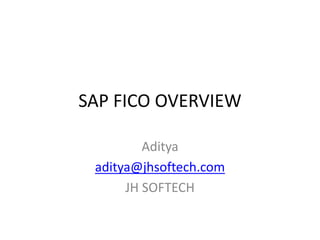
SAP FICO Overview
- 3. G/L Reporting Legal or external reporting • Balance sheet • Income Statement • Statement of Financial Position Financial Accounting
- 4. Stockholders Bankers, Lenders IRS, Taxing Authority External Auditors SEC Financial Accounting External Accounting Balance Sheet Profit & Loss Financial Position
- 5. CO/EC Overview COMPONENT Cost Center Acctg - CO-CCA Internal Orders CO-OPA Projects - PS Product Costing - CO-PC Activity Based Costing Profitability Analysis-CO-PA Profit Center Acctg-EC-PCA Executive Info. System-EC-EIS VIEW Costs Costs Costs Costs Costs Profits Profits Any data ROLE Cost Tracking Small Projects Large Projects Product Costing Cost Management Margin by multi-cuts Profit & Loss Repsons. Cross-module reports
- 6. Internal management reporting Reports by cost centers or other cost “objects” and cost elements Cost centers Orders and Projects Budget/plan Actual vs. plan CO Reporting Controlling
- 7. Controlling Internal Accounting Departmental Expense Report Salaries 10,000 Overhead 8,000 Other 5,000 Total 23,000 Department Managers ControllersExecutives Senior Management
- 8. FI and CO comparison COFI Legal or external reporting Reports by accounts Balance Sheet Income Statement Internal management reporting Reports by cost centers and cost elements Cost Center Reports
- 9. FI/CO Organizational Structures • Client • Company • Chart of Accounts • Company Code • Business Area • Credit Control Area • Controlling Area
- 10. CLIENT
- 11. Client • Highest hierarchical level in an SAP system • A complete database containing all the tables necessary for creating a fully integrated system • Master records are created at the client level
- 12. CLIENT COMPANY
- 13. Company • Consolidated financial statements are created at the company level • A company can include one or more company codes – All company codes must use the same chart of accounts and fiscal year
- 15. Chart of Accounts • A listing of the accounts • A chart of accounts must be assigned to every company code • Several company codes can use the same chart of accounts – A different chart of accounts can be used if a different grouping of the chart of accounts is required
- 16. Co code 1000 Co code 2000 Co code 3000 Co code 4000 Co code 5000 US CHART OF ACCOUNTS GERMAN CHART OF ACCOUNTS CLIENT
- 17. CLIENT COMPANY COMPANY CHART OF ACCOUNTS CHART OF ACCOUNTS COMPANY CODE COMPANY CODE COMPANY CODE
- 18. Company Code • A required structure • A legally independent entity • The smallest organizational unit for which accounting can be carried out • The level where business transactions are processed • The level where accounts are managed • The level where legal individual financial statements, such as the balance sheet and the profit and loss statement, are created A BALANCED SET OF BOOKS
- 19. CLIENT CHART OF ACCOUNTS CHART OF ACCOUNTS COMPANY CODE COMPANY CODE COMPANY CODE COMPANY COMPANY CREDIT CONTROL AREA CREDIT CONTROL AREA
- 20. Credit Control Area • An organizational unit or area of responsibility created to control customer credit limits • A company code is assigned to one and only one credit control area • Multiple company codes can be assigned to one credit control area
- 21. CLIENT CHART OF ACCOUNTS CHART OF ACCOUNTS COMPANY CODE COMPANY CODE COMPANY CODE COMPANY COMPANY CONTROLLING AREA CONTROLLING AREA
- 22. Controlling Area • An organizational unit defining the company's cost/ managerial accounting operations • A company code is assigned to one and only one controlling area • A controlling area can have multiple company codes assigned to it – This allows cross company cost allocations and reporting
- 23. 1 2 3 4 5 6 7 JANUARY FEBRUARY DECEMBER Fiscal Year Variant •Determines the fiscal year •Calendar year or non-calendar year •Allows the use of special periods to aid year-end closing •Is assigned to a company code
